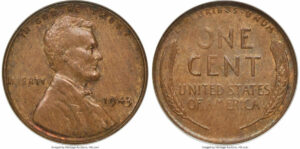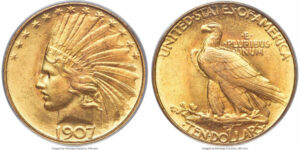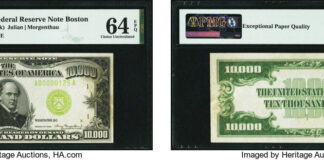Most Sought-After Error Coin of All Time for Sale
An extremely rare 1943 Lincoln cent that was struck on a bronze planchet, which has been called the most famous and sought-after error coin of all time, will be offered at auction for the first time ever when it crosses the block in Heritage Auctions’ Long Beach Expo/Summer FUN US Coins Signature® Auction 14th-17th July 2022.

The 1943 Cent Struck on a Bronze Planchet AU50 PCGS is an extreme rarity among a common mintage. “This coin has a fascinating story behind it,” says Mark Van Winkle, Chief Cataloger at Heritage Auctions. “1943 cents were not uncommon at all – hundreds of millions were struck. When copper was needed for the World War II war effort, for ammunition shell casings, they were struck in zinc-coated steel. This coin was among a few bronze planchets that stuck in the tote bins … only to get dislodged and fed into the presses, emerging in 1943 in a bin full of zinc-coated steel cents.”
“This is a previously unknown specimen. With only a light touch of wear at the AU50 grade level, this is an important coin, one that can significantly strengthen any serious collection of Lincoln cents or error coins.”
Demand grew, and not just because of the mere rarity. Rumors surfaced nationwide in the late 1940s that Henry Ford would give a new car to anyone who found a 1943 “copper” cent. The fact that Ford made no such promise was irrelevant, because the promise of a free car sent interest in the coin soaring. A few examples cropped up in circulation beginning in 1947, garnering such a spotlight that they prompted ads and stories in magazines and comic books over the next two decades. False promises or not, the coins brought high prices and generated long-term fascination – hence the excitement surrounding the coin offered in this auction.
Also offered is an exceptional 1841 Quarter Eagle PR50 NGC. JD-1, High R.6, which comes from one of the rarest issues – and widely recognized as one of the most intriguing – of all U.S. coins. Mint records show no 1841 P-mint quarter eagles were produced in any proof or circulation strikes, but “The Little Princess,” as it is known, does in fact exist. PCGS recognizes both proof and circulation strikes, while NGC acknowledges all 1841 quarter eagles as proofs. “The Little Princess” remains definitively rare in any format – Heritage Auctions has confirmed just 16 examples, including one that was reported stolen many years ago and has not been seen since. Three others reside in institutional collections, unavailable for public or private sale. The offered example, from the Allan H. Goldman Collection, is in its previous-generation PR50 NGC holder.
Another well-known numismatic rarity, also from the Allan H. Goldman Collection, is the 1827/3 Restrike Quarter, B-2, High R.6, PR63 PCGS, which is among the rarest of all U.S. quarter dollars. All 1827 quarters traditionally are described as being struck in proof format, although evolving grading criteria could make “proof-like” a more accurate description. Nine “original proofs,” thought to be struck in 1827, are confirmed; two experimental 1827 quarters were overstruck on Draped Bust quarters. Decades later, nine known restrikes were struck and accorded the Proof designation. The offered example is one of the two silver restrikes lacking the oblong indent on Liberty’s neck that is visible on late restrikes. The copper restrikes, which also lack this indent, were struck prior to the balance of the restrikes, which were struck circa 1876.

A 1907 Rolled Rim Ted Dollar MS66 PCGS is a rarity within the series, examples of which are coveted by pattern collectors and series specialists. Scarcer than all issues in the Indian eagle series except the 1933, the 1907 Rolled Rim is one of a surviving population estimated by PCGS CoinFacts of 40-42 pieces – most in the MS63-MS65 range. Two Rolled Rim examples are included in the National Numismatic Collection at the Smithsonian Institution and two more are in the collection of the American Numismatic Society.
A 1907 High Relief, Flat Rim, Twenty Dollar MS66+ PCGS CAC is an exceptional example of Saint-Gaudens’ transformation of modern coinage. Taking inspiration from Renaissance painter and sculptor Antonio Pisanello, Saint-Gaudens created lauded high relief designs that stood in stark contrast to the artistically dubious coinage of their respective eras. In 1892, the American Journal of Numismatics referred to the then-new dimes, quarters, and half dollars as “pleasing,” but a far cry from “the ideal National coin.” The Journal had resigned itself to the necessity and practicality of low relief coinage, though it maintained that only coins of high artistic integrity could truly capture the essence of America. In the case of the twenty dollar gold pieces struck in late 1907, the three-dimensionality of the figures on both obverse and reverse are singular in the history of American coinage.

From the Dr. Jerry Collection, a 1915-S $50 Panama-Pacific 50 Dollar Round MS63 PCGS. CAC reflected the artistic achievement and industrial advancement exemplified in the creation of the Panama-Pacific International Exposition. Congress authorized a total of 3,000 $50 Pan-Pac gold pieces to be produced – 1,500 Round and 1,500 Octagonal. The coins were hefty and impressive, representing not only the first gold pieces of that denomination struck for distribution by the United States Mint, but also recalling to mind the history of San Francisco and the U.S. Assay Office fifty dollar octagonal “slugs” that were an anchor of local commerce there during the height of the California Gold Rush. While several different sets, as well as individual coins could be purchased, no one was able to acquire even a single $50 Pan-Pac commemorative without parting with $100, which at the time was beyond the reach of virtually all potential buyers. Farran Zerbe eventually marketed these coins in sets to wealthy bankers, producing more sales, but distribution ultimately trickled out at 645 Octagonal pieces and 483 Round. The remainder of the coins were melted down.
From the Cody Brady Collection, Park IV, comes a 1930-S Eagle MS66 PCGS. CAC so spectacular that only one example (from the Duckor and O’Neal collections) has been graded finer (MS67) by PCGS. That the Indian Head ten dollar gold piece claimed one of the lowest mintages in the series – just 96,000 were struck – would be ample reason for the strong collector demand. But what makes this late-date key prized among serious collectors is its status as a melt rarity – it is estimated that as many as 95,000 were melted following the Gold Recall of 1933. It is believed that only 150-200 1930-S eagles survive today in all grades, and of those, all but about 10 are in Mint State. Certification totals at PCGS likely are inflated by resubmissions, but they do offer some explanation for the rarity of the 1930-S: the offered example is one of just five Premium Gems, one of which boasts a Plus designation.

Also from the Allan H. Goldman Collection, an 1854-S Liberty Quarter Eagle VF25 NGC is an important historic issue and extremely rare. It is one of only 246 struck, making it one of the rarest gold coins ever issued – so rare that PCGS CoinFacts estimates that just 11 or 12 remain in any grade, and one of those is in the National Numismatic Collection at the Smithsonian, and never will end up in a private collection. The San Francisco Mint received its first gold deposits when it opened April 3, 1854, roughly two weeks before the production of regular-issue coinage began, with 178 double eagles, followed over the next two days by 260 eagles, 268 half eagles and 246 quarter eagles. The desire by depositors to request reimbursement in large denominations prompted the Mint to concentrate its limited resources on production of double eagles and eagles for the rest of the year, along with a small mintage of gold dollars, which were useful in small transactions. No more quarter eagles or half eagles were struck in 1854, making both issues landmark rarities today. The minuscule production of 1854-S quarter eagles slipped quietly into circulation at the time of issue and no high-quality examples were saved by contemporary collectors.
Other top lots include, but are not limited to:
- A 1915-S $50 Panama-Pacific 50 Dollar Octagonal MS63 PCGS. CAC
- A 1930-S Eagle MS66 PCGS. CAC
- An 1854-S Quarter Eagle VF25 NGC
- A 1907 Wire Rim Eagle MS67 PCGS
Images and information about all lots in the auction can be found in the online catalog.
For further information, visit the Heritage Auctions website.




